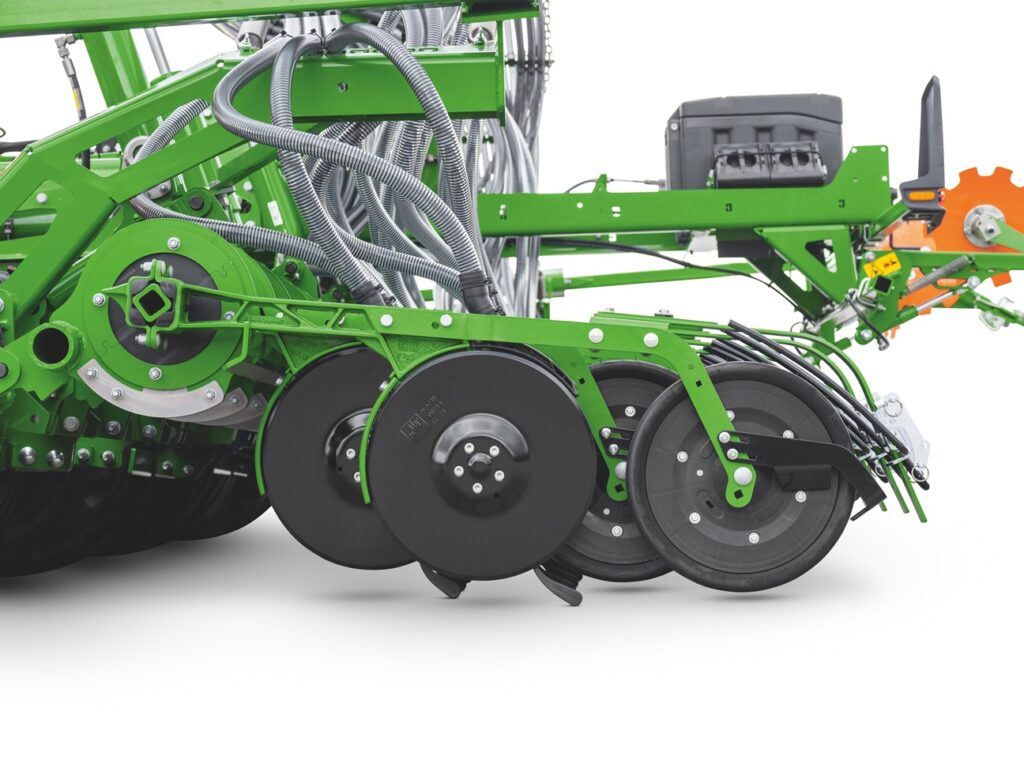With Amazone notching up 140 years of machinery manufacturing last year, Direct Driller takes a look at how its technology has developed.
Over one million fertiliser spreaders have been built by Amazone, and 2024 is the 75th anniversary seed drill production for the company. Based in Osnabrück, Germany and manufacturing at eight sites across the world, Amazone is owned by the Dreyer family and is now looked after by the fourth generation. The company has a long history in both crop establishment and crop care equipment and seeks to establish itself as the ‘harvest to harvest specialist’.
Dr. Heinz Dreyer brought the first PTO-driven twin disc mounted spreader, the ZA, onto the market in 1958 putting Amazone firmly on the map in the world of spreaders. Nowadays, the flagship TS spreading system, in either a mounted 5000-litre or trailed 10,000-litre hopper format, offers up to 54m spreading widths and 128 section shut-off. The technology on board includes the TS border spreading system, ArgusTwin radar spread pattern monitoring and automatic adjustment of any wind influence through WindControl. Such advances were not even dreamed of back when the first ZA was put in the field.
As well as drills and fertiliser spreaders, there’s been over 50 years of sprayer production. The S400 mounted sprayer started in 1969 with a 400-litre spray tank and 6m boom and now encompasses mounted sprayers up to 3500 litres, trailed up to 11,200 litres and the Pantera self-propelled including the all-new, self-levelling, 7000-litre Pantera 7004.
The last 75 years has seen huge changes in crop establishment methods. The D1 seed drill was introduced just after the second world war and was soon joined up to a cultivator with the development of the RE reciprocating harrow making the first drill combination. The following 75 years has seen both the level of technology and the breadth of the range multiply exponentially.






Those linkage- and harrow-mounted drills and drill combinations still form a significant part of the thousands of drills produced each year. But changing establishment methods have seen a diversification into trailed tine seeders, direct-tine seeders and solo trailed disc drills along with the multi-purpose Cirrus drills. The need to sow multiple seed varieties at different rates, and also at different planting depths, has led to drills with multiple hoppers and coulter systems. This can also be used to sow a mixture of seed and fertiliser either alongside the seed as a SingleShoot system, or at a different depth using the FerTeC coulters in a DoubleShoot set-up. An additional GreenDrill seeder box can be added for a third material including the application of micro-granular herbicides and slug pellets.
The renewed emphasis on direct and low-disturbance drilling has seen an increasing demand for tined drills that can direct drill into surface residues and cover crops and yet, as opposed to disc drills, still generate a clean seed slot to ensure good seed/soil content. The Primera DMC offers the flexibility of being able to be used conventionally, in a min-till scenario or as a direct seeder. The relatively close row spacing of 18.75cm, set in a four-row opener lay-out, offers generous point-to-point clearance and allows the Primera to handle drilling in trashy conditions. And the same can be said of the 12m and 15m Condor seeders. The 7800-litre seed hopper is split into three sections to give maximum flexibility and the ConTeC pro openers in three stagger and a 25cm row spacing again give good throughput.
Fast forward to 2024 and one of the latest additions is the new Cirrus 9004 Grand trailed cultivator drill. Designed for high output, the Cirrus Grand comes in a 9m working width and with a split 5750-litre seed hopper that can supply both seed only or seed and fertiliser to the TwinTeC+ double disc coulters. The seed is distributed to the coulter via the new seed-on-demand, individual row shut off head.
Any tramline width or wheel track width can be set from the terminal. When a row is isolated, for tramlining or on headland ins and outs, the seed is kept circulating within the head until needed, this gives instant response to any situation leading to minimal misses and overlaps. The air flow to the coulter is always there and remains constant across the full drill width to avoid blowing the seed out of the seed row as more rows are isolated. The V-Compensation system means that on the way out of the headland, the longer pipe runs are started first to ensure even seed delivery across the whole working width or, on entering the headland, the longer pipe runs stop first giving a uniform emergence over the whole field.
Whatever the model of drill chosen, keeping that flexibility of drilling open is key to being able to cope with any upcoming political and environmental pressures that farming may face in the future.


